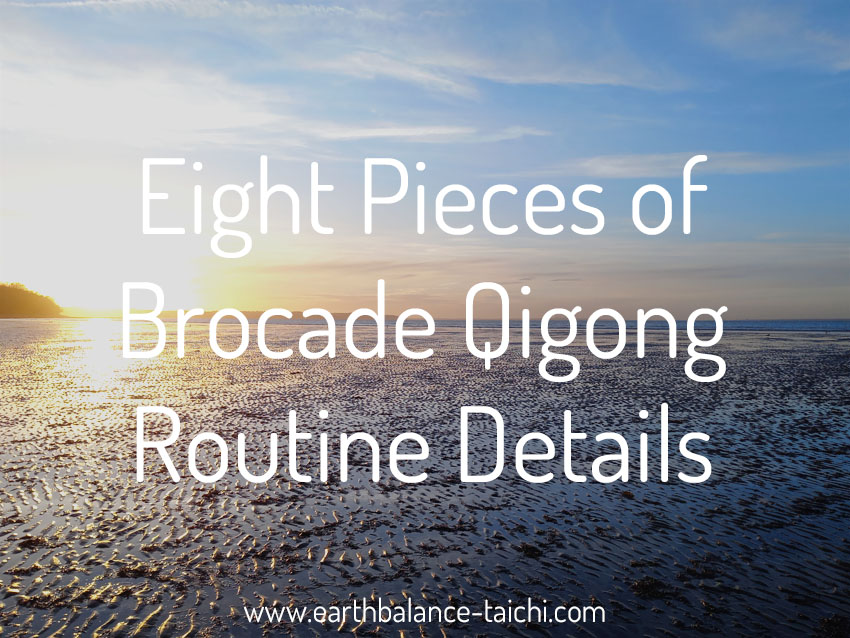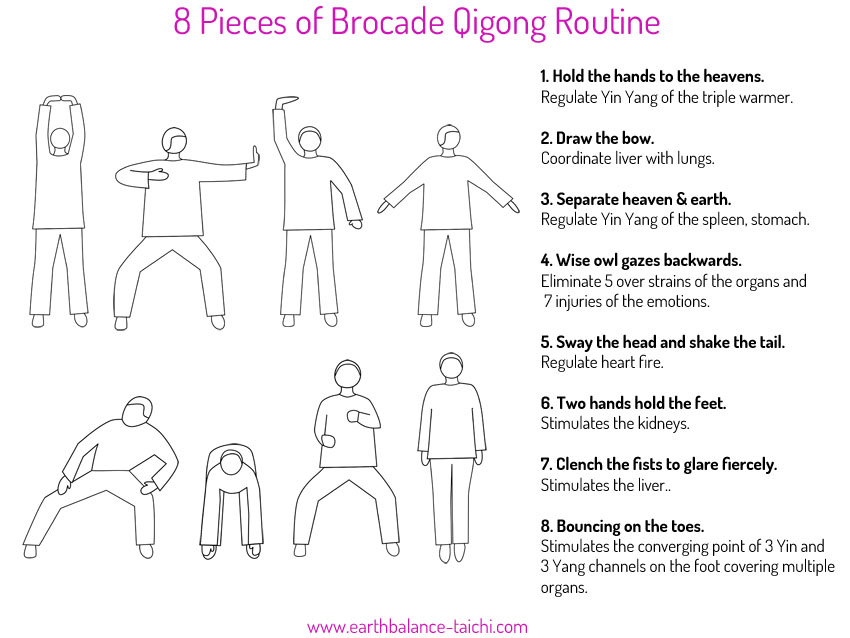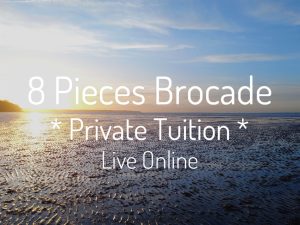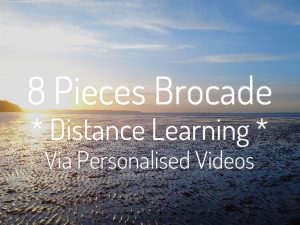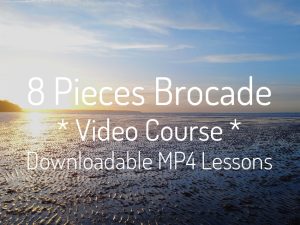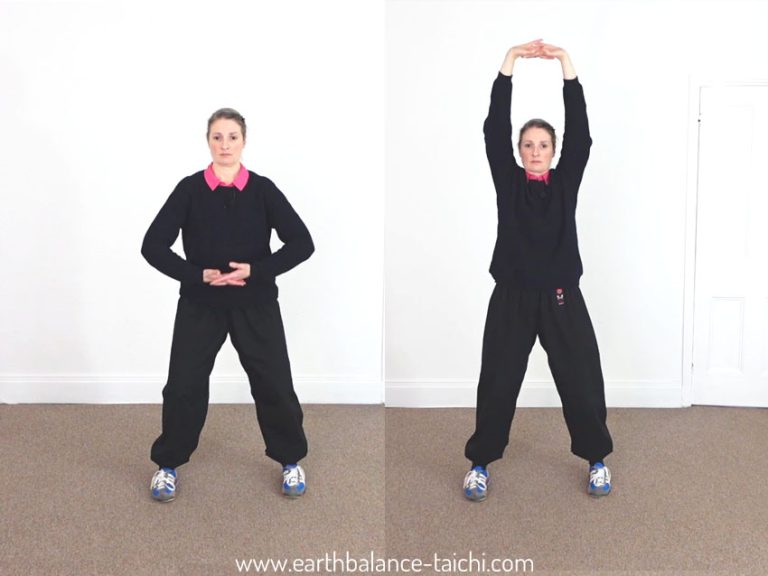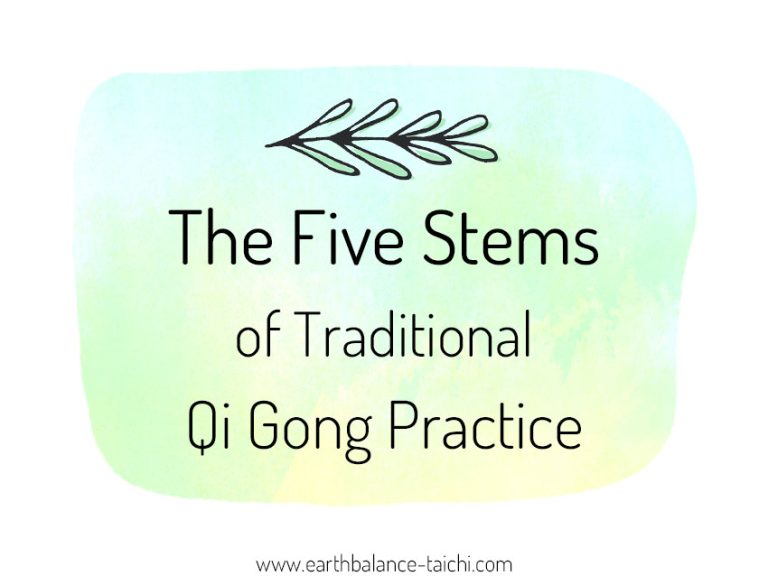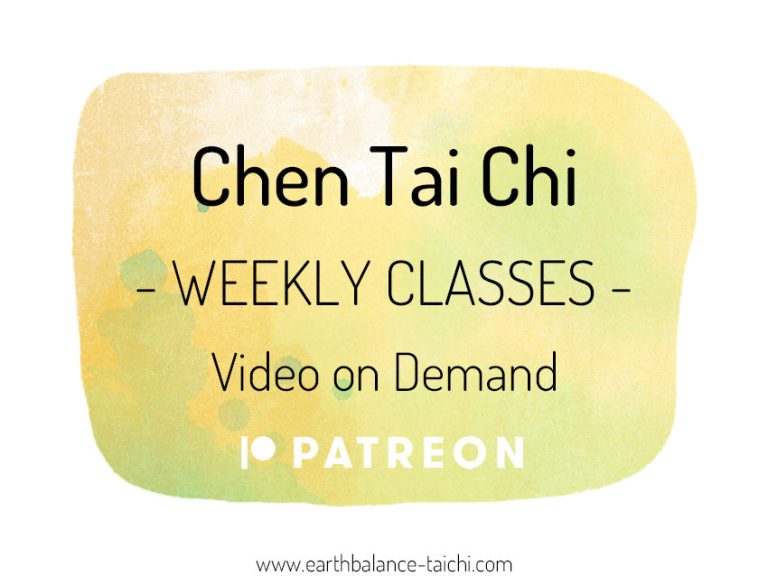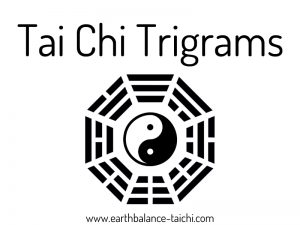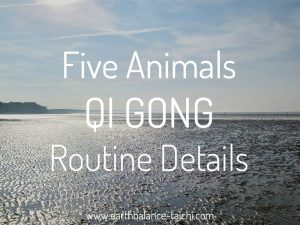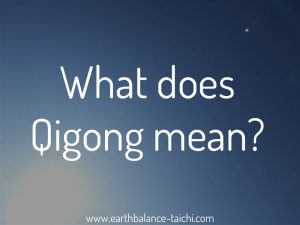Eight Pieces Brocade
The eight pieces brocade is a traditional Qi Gong (also called Chi Gung) routine dating back to the Song Dynasty in China. The Eight Pieces of Brocade / Ba Duan Jin consists of eight movements focusing on health preservation. Guide the body through opening and closing movements to calm the mind and strengthen the body. This blog post shares details on the movements, the key aspects of each posture within the routine and the corresponding Traditional Chinese Medicine health benefits.
Traditionally there are many teachers and lineages of the eight pieces brocade Qigong stemming from the original practice, where the routine has been passed down from teacher to student over many hundreds of years. Today in the modern world, the eight pieces of brocade qigong routine was standardised by the Chinese government between 2000-2003, establishing the Chinese Health Qigong Association to bring their system to a global market. The eight key movements have differences and similarities between schools and systems.
Eight Pieces Brocade - Health benefits
Balancing health through movement, breath work and awareness. Qi gong to nourish your spine health. Other health benefits include a boost to the immune system, strengthen the muscles, massage the internal organs, lengthen the connective tissue, improve blood circulation, pump the lymph system, increase lung capacity and regulate your breathing.
Eight Pieces Brocade - TCM benefits
Dredge the Triple Warmer, regulate the spleen and stomach, harmonize Qi movement, remove heart fire, balance Yin and Yang, dredge and clear the meridian channels, strength the waist and kidneys. Stimulation of the Du meridian channel along the spine and bladder meridian channel acupuncture points either side of the spine, connecting to all of the meridian channels and organs.
Ways to Learn the Eight Pieces Brocade Qigong / Ba Duan Jin
From £10 pcm + VAT
From £37 per hour
From £40 per hour
Cost £45
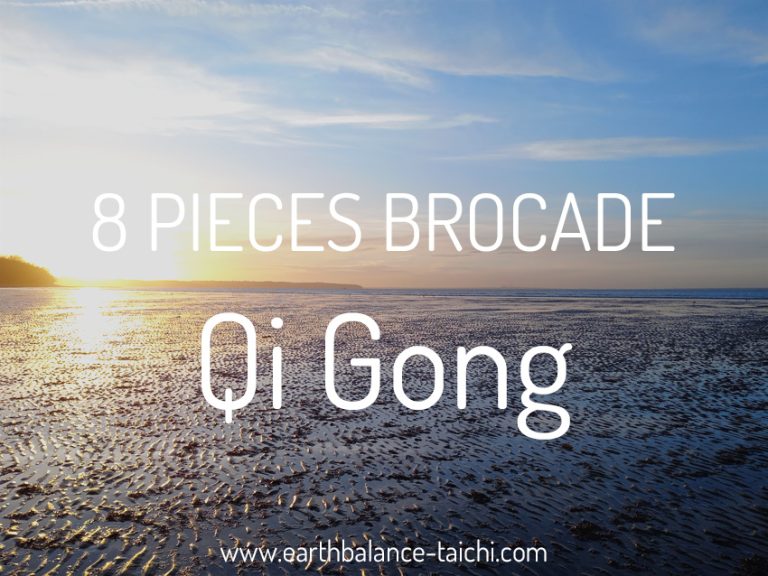
EIGHT PIECES OF BROCADE ROUTINE
Opening Standing Posture
- Starting Posture: Wuji posture, hands down by sides, palms facing the legs. Follow the alignment principles of traditional Zhan Zhuang practice.
- Movement: Feet together, step out with the left foot. Circle the hands by pushing them backwards and around to in front of the lower abdomen. Sink into a kua squat. Co-ordinate with the breath. Perform once.
- Zhan Zhuang: Maintain the standing posture whilst breathing deeply.
- Spine involvement: Maintain an upright spine.
1. Two Hands Hold up the Heavens
- Health: Lower heart rate, lower blood pressure, relaxes tense & stiff muscles.
- TCM: Regulate Yin Yang of the triple warmer.
- Movement: Interlink and raise both palms to the chest. Rotate the palms out whilst lifting the chin and following the palms raising with the eyes. Tuck the chin in, relax the shoulders and stretch the arms up overhead. Release the arms circling them down whilst sinking into a kuq squat.
- Spine involvement: Maintain an upright spine as you raise up and lower down, with an equal pushing and pulling force in the palms that stabilises the spine. Qi is drawn through the body to the Lao Gong acupuncture points. These are in the centre of the palms, called the Pericardium 8 point, and seen to calm the spirit.
- Repetitions: Six.
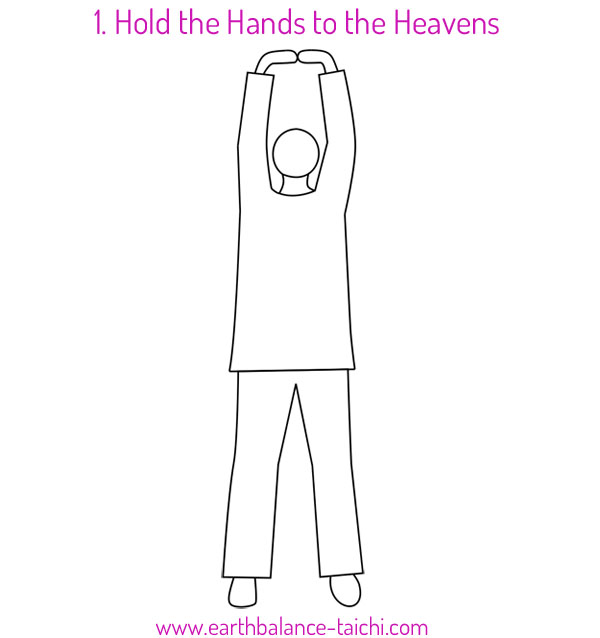
2. Drawing the Bow
- Health: Strengthens knees, legs, waist and back, coordination.
- TCM: Coordinate liver with lungs.
- Movement: Maintain the hips and shoulders facing forwards. Cross the arms in front of the chest. Step into a horse stance. Sink into a kua squat, whilst expanding the arms to the left and right with equal opposing force in the elbow and palm. Turn the head to look at the arrow head. The ‘drawing’ palm posture is grasping the string of the bow. The ‘arrow head’ palm posture with the index finger extended and the other fingers curled down, pressing to one side with the heel of the palm. Pause at the top of the movement. Return to the start of the movement.
- Spine involvement: Maintain an upright spine as you raise up and lower down. Balance the left and right directions of the spine as the arms expand to draw the bow. Stimulates relaxation in the two Jia Ji acupuncture points opposite the chest on either side of the spine. The Jia Ji has 17 points on each side of the spine, the centre is called the middle gate and is located in the middle back either side of the Du meridian.
- Repetitions: Six.

3. Separate Heaven and Earth
- Health: Opens chest area, helps respiration, relaxes tension in shoulders, back and abdomen.
- TCM: Regulate Yin Yang of the spleen, stomach.
- Movement: Maintain the hips and shoulders facing forwards. Rise out of a kua squat as the hands separate and rotate, one lifting up and pressing a flat palm to the sky above the shoulder, and one lowering down and pushing a flat palm to the ground next to the hip. This action expands the trunk. Lower the palms down whilst sinking into a kua squat.
- Spine involvement: Maintain an upright spine with equal opposing force in the palms that stretches the spine. Qi is drawn through the body to the Lao Gong and the central Jia Jii acupuncture points.
- Repetitions: Six.
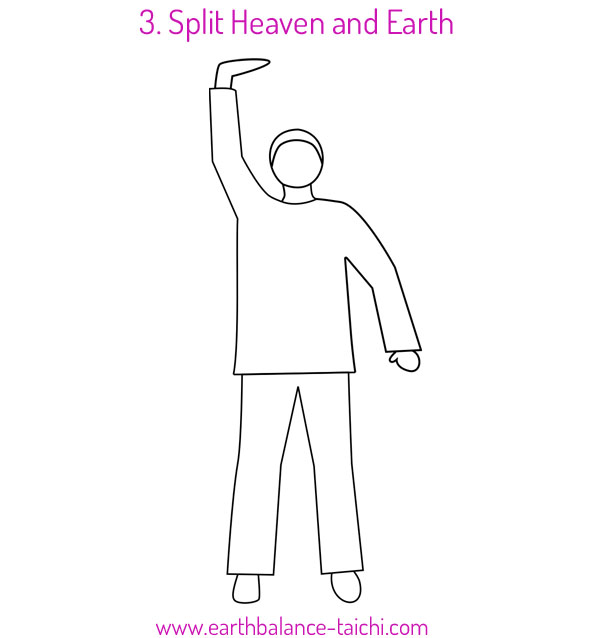
4. Wise Owl Gazes Backwards
- Health: Helps tension in neck and eye muscles, coordination.
- TCM: Eliminate 5 over strains of the organs and 7 injuries of the emotions.
- Movement: Start with the palms at the trouser seam. Open the arms into a diagonal position at the sides of the body. Rotate the arm from the shoulder, spiralling the arms backward, with the thumbs turning upwards. This stretches and expands the chest and the shoulders. Turn the head with the chin tucked in to the side, with your eyes looking behind and down to the ground passed your shoulder. Keep the shoulders facing the front. Pause at the top of the movement.
- Spine involvement: The spine is held upright by both shoulders spiralling out and down with the palms pressing down. Qi is drawn through the body to the Jia ji acupuncture points.
- Repetitions: Six.
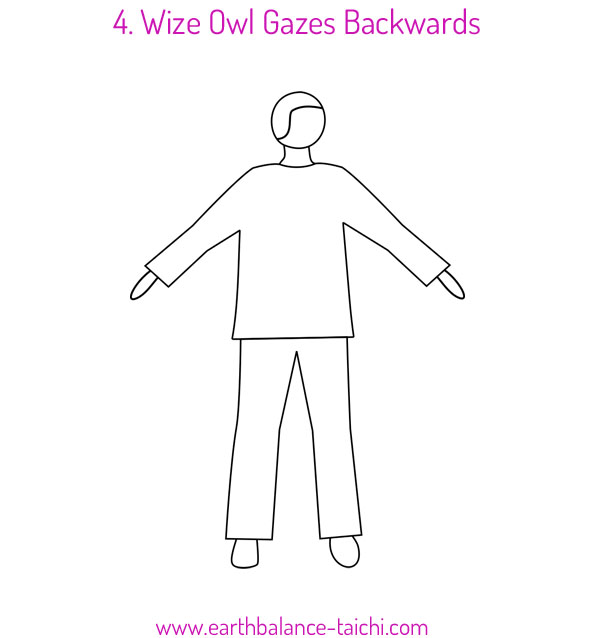
5. Sway the Head and Shake the Tail
- Health: Strengthens knees, legs, waist and back, coordination, lessens stress.
- TCM: Regulate heart fire (stress) by lowering the heart below the kidneys, to pour kidney water onto the fire in the heart.
- Movement: Step out into a horse stance. Fold and tilt the spine around a half circle. Maintain a straight upper body.
- Spine involvement: The spine stays straight as it stretches away from the hips through the crown, rotating and folding and sweeping from left to right, and right to left. The spine is held stable via the opposing pressure through the legs and feet into the ground.
- Repetitions: Six.

6. Two Hands Hold the Feet
- Health: Strengthens waist, stretches spine.
- TCM: Stimulates the kidneys.
- Movement: Start with the palms raised above the shoulders. Lower the palms down with the fingertips pointing to each other until they reach under the chest. Move the palms under the armpits with the thumbs on the side of the ribs. Push the palms down the back, when the palms reach the lower back / buttocks, forward bend with a straight spine / straight legs (micro bend) whilst the palms rub down the legs to the ankles. Place the palms on top of the shoes. Look forwards and push the arms forwards until they are parallel to the floor. Tilt the pelvis under to give momentum to raise up to standing.
- Spine involvement: The spine stays straight as it stretches away from the hips through the crown, with a forward bend (flexion) towards a relaxed spine at the base of the movement.
- Repetitions: Six.

7. Clench the Fists and Glare Fiercely
- Health: Strengthens knees, legs, waist and back, coordination, helps lessen anger.
- TCM: Stimulates the liver.
- Movement: Step out into a horse stance. Closed fists with the thumb on the inside sit on the hips Push a single fist out by turning the waist. Withdraw the fist to the hip. The eyes maintain an intense focus on the fist.
- Spine involvement: The spine is held upright and stable via the opposing pressure between the rotating fists and the force going through the legs and feet into the ground.
- Repetitions: Six.
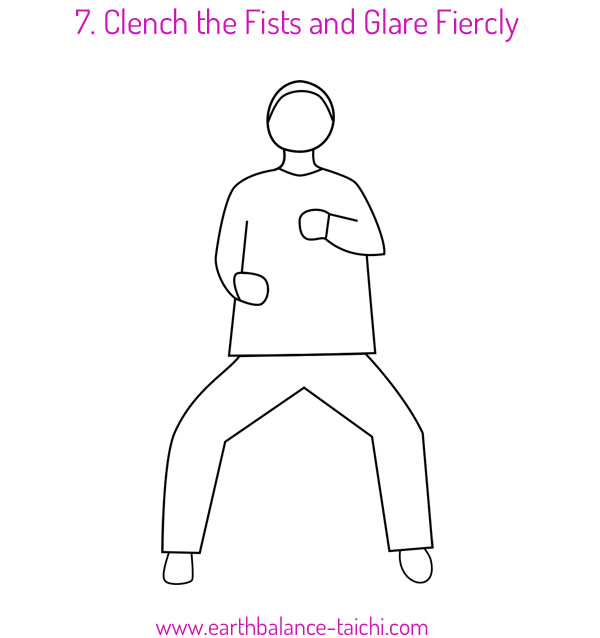
8. Bouncing on the Toes
- Health: Strengthens calves and legs, stretches and lengthens Achilles tendons and spine.
- TCM: Stimulates the converging point of 3 Yin and 3 Yang channels on the foot covering multiple organs. Helps to return the body to the original essence.
- Movement: Feet together. Raise the heels whilst stretching and raising up from the crown. Hold the thighs together, withdraw the abdomen at the same time as contracting the buttocks. This assists balance. Lower the feet half way and ten drop the heels to the ground. When dropping maintain a relaxed body.
- Spine involvement: Maintain an upright spine as you raise up and lower down, with a drop of the heels that vibrates the spine.
- Repetitions: Seven.
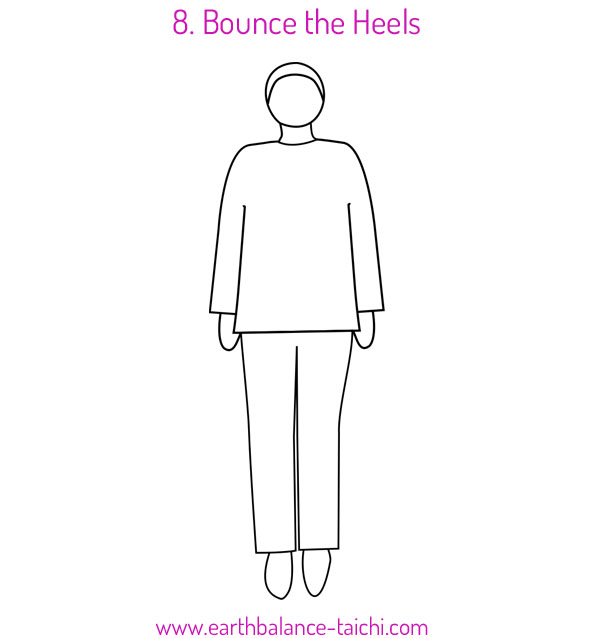
Closing Set
- Movement: Circle the hands by pushing them backwards and around to in front of the lower abdomen. Sink in and out of a kua squat. Co-ordinate with the breath. Perform three times. Use the palms to massage the face and limbs.
- End posture: Step the feet together. Place the hands one over the other on the lower abdomen. Relax the mind, the breath, the body and the spine.
** Eight Pieces Brocade - Please speak with your doctor prior to starting a new exercise programme. This article is for information purposes only and must not be taken as medical advice. **
The Five Stems Video Course
Interested to know more about Qigong? Learn about the five stems of the traditional learning process here. Join my FREE five day mini video course available to newsletter subscribers via this link.
